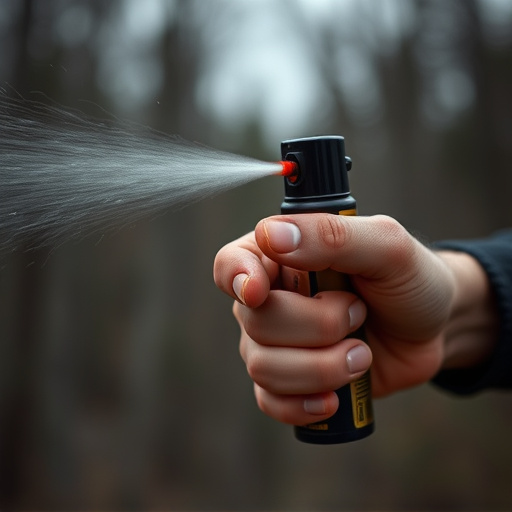Pepper spray, a common less-lethal weapon, causes temporary blindness and severe eye irritation due to its active ingredient capsaicin. To counteract this, the Pepper Spray Eye Washing Procedure recommends immediate flushing of eyes with copious amounts of clean water (at least 15 minutes), blinking rapidly, using eye wash solutions if available, and seeking medical attention for persistent symptoms. First responders must follow strict decontamination protocols, including removing contaminated clothing, washing affected areas, and ensuring proper training and equipment to safely manage pepper spray incidents.
“Discover the powerful compound that is police-grade inflammatory pepper spray, its composition, and its impact. This article delves into the science behind its eye irritation prevention, offering a comprehensive guide to effective pepper spray eye washing procedures. From understanding the chemistry to best practices for first responders, learn essential safety measures to navigate this potent tool. Enhance your knowledge on pepper spray eye washing to ensure swift and safe response.”
- Understanding Pepper Spray Composition and Its Impact
- The Science Behind Eye Irritation and Damage Prevention
- Step-by-Step Guide to Effective Pepper Spray Eye Washing Procedure
- Best Practices and Safety Measures for First Responders
Understanding Pepper Spray Composition and Its Impact
Pepper spray, a common less-lethal weapon used by law enforcement and security personnel worldwide, is designed to incapacitate individuals temporarily through the activation of nerve endings in the eyes, nose, and throat. The primary active ingredient in most pepper sprays is capsaicin, derived from chili peppers. This compound stimulates the release of neurotransmitters that cause intense pain, tearing, and inflammation. Understanding the composition of pepper spray is crucial as it helps explain its immediate impact on the body’s sensory systems.
When pepper spray comes into contact with the eyes, it triggers a rapid response. The eye washing procedure becomes an essential step in mitigating the effects. Immediate irrigation with clean water can help flush out the spray, reducing irritation and pain. However, the impact of capsaicin is multifaceted; it not only affects the eyes but also respiratory distress due to the inhalation of sprayed particles. Thus, proper training on both the application and de-escalation techniques of pepper spray, as well as its eye washing procedure, is vital for all law enforcement personnel to ensure safe and effective use.
The Science Behind Eye Irritation and Damage Prevention
The eyes are particularly vulnerable to the effects of pepper spray due to their high density of nerve endings and blood vessels. When pepper spray is deployed, the capsaicin compound it contains binds to these receptors, triggering a severe inflammatory response. This reaction leads to intense pain, tearing, and temporary blurriness—a combination that can impair vision significantly.
To mitigate eye irritation and potential damage from pepper spray exposure, a swift and effective eye washing procedure is crucial. The recommended approach involves thorough irrigation with large volumes of clean water for at least 15 minutes. This washes away the pepper spray residue, reducing its contact with the eye’s sensitive surfaces. Additionally, using specialized eye-washing stations or portable eye-washing devices can aid in this process, ensuring a more controlled and efficient decontamination.
Step-by-Step Guide to Effective Pepper Spray Eye Washing Procedure
In the event of exposure to pepper spray, immediate and thorough eye washing is crucial to minimize discomfort and prevent potential damage. Here’s a step-by-step guide for an effective Pepper Spray Eye Washing Procedure.
1. Remove Contact Lenses (if worn): If you have contact lenses on, gently remove them with your fingers or using an appropriate solution. Proceed with washing even if the lenses are not irritating the eyes.
2. Rinse with Clean Water: Hold your head under a gentle, running tap of clean water for at least 15 minutes. Ensure the water is not too hot or cold, maintaining a comfortable temperature. The longer you rinse, the better, as it helps to dilute and disperse the pepper spray compound.
3. Blink Frequently: As you rinse, blink your eyes rapidly several times. This helps to spread the water across the eye surface, ensuring thorough washing.
4. Use Eye Wash Solution (if available): If an eye wash solution is readily available, follow instructions for its use. These solutions are designed to enhance the flushing process and may contain additional soothing ingredients.
5. Seek Medical Advice if Needed: Despite proper rinsing, if irritation persists or intensifies, or if you experience any unusual symptoms like vision changes, seek immediate medical attention.
Best Practices and Safety Measures for First Responders
First responders, including law enforcement officers and emergency medical personnel, must adhere to strict best practices and safety measures when handling pepper spray compounds. After deployment, it’s crucial to immediately initiate a thorough decontamination procedure. This includes removing any contaminated clothing or gear and washing affected areas with soap and water. For eye exposure, the Pepper Spray Eye Washing Procedure should be promptly executed. This involves irrigating the eyes with clean water for at least 15 minutes to flush out any remaining spray residue.
Safety measures extend beyond the immediate decontamination process. First responders should wear protective gear, such as chemical-resistant gloves and eye protection, during interactions involving pepper spray. Regular training sessions focused on proper usage, handling, and decontamination procedures are essential to ensure officers remain safe and effective in their roles. Additionally, maintaining a well-stocked emergency kit equipped with eye wash stations and decontaminants is vital for swift response to any pepper spray incidents.
In conclusion, understanding the composition of pepper spray and its impact is crucial for effective eye washing procedures. By mastering the science behind eye irritation prevention and adopting best practices for first responders, we can ensure safer interactions with inflammatory compounds like pepper spray. Remember that proper eye washing techniques are a game-changer in mitigating damage and providing prompt relief. Implement these strategies to enhance safety measures during critical situations involving pepper spray exposure.
